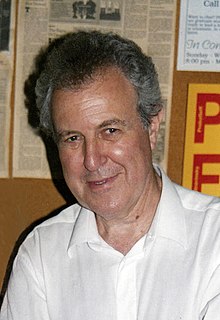
In theoretical physics, a Feynman diagram is a pictorial representation of the mathematical expressions describing the behavior and interaction of subatomic particles. The scheme is named after American physicist Richard Feynman, who introduced the diagrams in 1948. The interaction of subatomic particles can be complex and difficult to understand; Feynman diagrams give a simple visualization of what would otherwise be an arcane and abstract formula. According to David Kaiser, "Since the middle of the 20th century, theoretical physicists have increasingly turned to this tool to help them undertake critical calculations. Feynman diagrams have revolutionized nearly every aspect of theoretical physics." While the diagrams are applied primarily to quantum field theory, they can also be used in other fields, such as solid-state theory. Frank Wilczek wrote that the calculations which won him the 2004 Nobel Prize in Physics "would have been literally unthinkable without Feynman diagrams, as would [Wilczek's] calculations that established a route to production and observation of the Higgs particle."
In physics, string theory is a theoretical framework in which the point-like particles of particle physics are replaced by one-dimensional objects called strings. String theory describes how these strings propagate through space and interact with each other. On distance scales larger than the string scale, a string looks just like an ordinary particle, with its mass, charge, and other properties determined by the vibrational state of the string. In string theory, one of the many vibrational states of the string corresponds to the graviton, a quantum mechanical particle that carries the gravitational force. Thus, string theory is a theory of quantum gravity.
In physics, action is a numerical value describing how a physical system has changed over time. Action is significant because the equations of motion of the system can be derived through the principle of stationary action. In the simple case of a single particle moving with a specified velocity, the action is the momentum of the particle times the distance it moves, added up along its path, or equivalently, twice its kinetic energy times the length of time for which it has that amount of energy, added up over the period of time under consideration. For more complicated systems, all such quantities are added together. More formally, action is a mathematical functional which takes the trajectory, also called path or history, of the system as its argument and has a real number as its result. Generally, the action takes different values for different paths. Action has dimensions of energy × time or momentum × length, and its SI unit is joule-second.

The path integral formulation is a description in quantum mechanics that generalizes the action principle of classical mechanics. It replaces the classical notion of a single, unique classical trajectory for a system with a sum, or functional integral, over an infinity of quantum-mechanically possible trajectories to compute a quantum amplitude.

In physics, Faddeev–Popov ghosts are extraneous fields which are introduced into gauge quantum field theories to maintain the consistency of the path integral formulation. They are named after Ludvig Faddeev and Victor Popov.
In physics, the pomeron is a Regge trajectory — a family of particles with increasing spin — postulated in 1961 to explain the slowly rising cross section of hadronic collisions at high energies. It is named after Isaak Pomeranchuk.
In quantum physics, Regge theory is the study of the analytic properties of scattering as a function of angular momentum, where the angular momentum is not restricted to be an integer multiple of ħ but is allowed to take any complex value. The nonrelativistic theory was developed by Tullio Regge in 1959.

Hagen Kleinert is professor of theoretical physics at the Free University of Berlin, Germany , Honorary Doctor at the West University of Timișoara, and at the Kyrgyz-Russian Slavic University in Bishkek. He is also Honorary Member of the Russian Academy of Creative Endeavors. For his contributions to particle and solid state physics he was awarded the Max Born Prize 2008 with Medal. His contribution to the memorial volume celebrating the 100th birthday of Lev Davidovich Landau earned him the Majorana Prize 2008 with Medal. He is married to Dr. Annemarie Kleinert since 1974 with whom he has a son Michael Kleinert.

Geoffrey Foucar Chew was an American theoretical physicist. He is known for his bootstrap theory of strong interactions.
The term "bootstrap model" is used for a class of theories that use very general consistency criteria to determine the form of a quantum theory from some assumptions on the spectrum of particles. It is a form of S-matrix theory.
Isaak Yakovlevich Pomeranchuk was a Soviet theoretical physicist working in particle physics, quantum field theory, electromagnetic and synchrotron radiation, condensed matter physics and the physics of liquid helium. The Pomeranchuk instability, the pomeron, and a few other phenomena in particle and condensed matter physics are named after him.
Stanley Mandelstam was an American theoretical physicist. He introduced the relativistically invariant Mandelstam variables into particle physics in 1958 as a convenient coordinate system for formulating his double dispersion relations. The double dispersion relations were a central tool in the bootstrap program which sought to formulate a consistent theory of infinitely many particle types of increasing spin.
The history of string theory spans several decades of intense research including two superstring revolutions. Through the combined efforts of many researchers, string theory has developed into a broad and varied subject with connections to quantum gravity, particle and condensed matter physics, cosmology, and pure mathematics.
Steven C. Frautschi is an American theoretical physicist, currently professor of physics emeritus at the California Institute of Technology (Caltech). He is known principally for his contributions to the bootstrap theory of the strong interactions and for his contribution to the resolution of the infrared divergence problem in quantum electrodynamics (QED). He was named a Fellow of the American Physical Society in 2015 for "contributions to the introduction of Regge poles into particle physics, elucidation of the role of infrared photons in high energy scattering, and for seminal contributions to undergraduate physics education".
Vladimir Naumovich Gribov was a prominent Russian theoretical physicist, who worked on high-energy physics, quantum field theory and the Regge theory of the strong interactions.

Alexey Andreevich Anselm was a Russian theoretical physicist, Doctor of Physical and Mathematical Sciences, professor, director (1992–1994) of the B.P. Konstantinov Petersburg Nuclear Physics Institute (PNPI), member of: the Russian and American Physical Society, the executive committee of the Nuclear Physics Branch of the Russian Academy of Sciences, the editorial board of the Russian journal “Yadernaya Fizika”.
In particle physics, initial and final state radiation refers to certain kinds of radiative emissions that are not due to particle annihilation. It is important in experimental and theoretical studies of interactions at particle colliders.

In mathematics and theoretical physics, an amplituhedron is a geometric structure introduced in 2013 by Nima Arkani-Hamed and Jaroslav Trnka. It enables simplified calculation of particle interactions in some quantum field theories. In planar N = 4 supersymmetric Yang–Mills theory, also equivalent to the perturbative topological B model string theory in twistor space, an amplituhedron is defined as a mathematical space known as the positive Grassmannian.
John Clayton Taylor is a British mathematical physicist. He is an Emeritus Professor of Mathematical Physics at the Department of Applied Mathematics and Theoretical Physics of the University of Cambridge and an Emeritus Fellow of Robinson College. He is the father of mathematician Richard Taylor.






